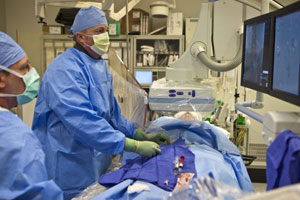
|
|
Interventional Radiology Ablative Services
The vascular and interventional radiologists with the UC Irvine Health Ablative Oncology Center offer a wide range of ablative services to treat a variety of conditions. They include:
| Conditions | Services |
|
|
Embolotherapy

Embolization is another ablative technique used by vascular and interventional radiologists to treat many benign and malignant conditions. In general, it involves steering very thin plastic tubes called catheters through the body's blood vessels to an abnormality.
Guided by live X-ray imaging, the interventional radiologist then positions the catheter at the tumor's arterial blood supply and sends specific therapeutic agents through the catheter to block blood flow to the tumor.
Embolization agents used by our vascular and interventional radiologists include:
- Drug-eluting beads (small particles impregnated with a chemotherapy agent)
- Radioembolics (small glass or polymer particles containing radioactive material, such as Therasphere® or SIR-Spheres)
- “Bland” particles (particles without chemotherapy or radioactive agents that are inserted to cut off a tumor’s blood supply)
- Alcohol (injected in benign tumors and other abnormalities)
Team approach
If you qualify for image-guided, minimally invasive therapy, your interventional radiologist will work closely with your entire healthcare team to identify the best treatment for your condition. You will have a consultation with the interventional radiologist to discuss your options and the details of your therapy.
Most vascular and interventional radiology procedures are done with sedation, although some require general anesthesia. Patients frequently are discharged after a short observation period in the hospital.
Other services
Many additional services for patients with cancer are performed by UC Irvine vascular and interventional radiologists. These include placement of ports or other forms of vascular access for chemotherapy, drainage of abnormal fluid or placement of feeding tubes that are used during treatment.
Clinical trials
Because Ablative Oncology Center physicians are actively engaged in research at UC Irvine Medical Center, Orange County's only university medical center, UC Irvine patients also have access to innovative treatments through clinical trials long before they are available to the general public. Learn more about UC Irvine clinical trials ›
For more information or to contact a vascular and interventional radiologist, call 877-UCI-DOCS (877-824-3627).